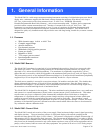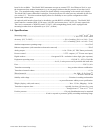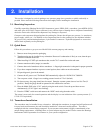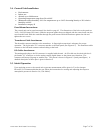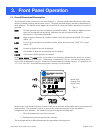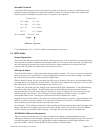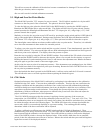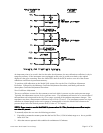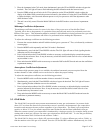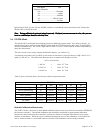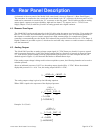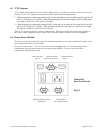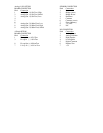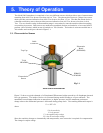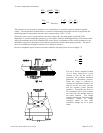149-072011 Model 2002 Vacuum Gauge Page 12 of 38
3. Place the instrument in the CAL mode, then simultaneously press the UP and DOWN switches to bypass the
interlock. The CAL light will start to flash indicating that the calibration mode has been activated.
4. Press the ZERO switch once if below 6x10-5 Torr otherwise use the UP and DOWN switch to adjust the
display of the Model 2002 to match the pressure indicated by the reference. If using the UP and DOWN switch
to adjust the display, wait 20 seconds between presses at very low pressure to allow the adjustment to take
affect the data to settle.
5. The unit is now fully zeroed. Place the Model 2002 back in the RUN mode to store the zero in permanent
memory.
Midrange Coefficient Adjustment
The midrange coefficient corrects for errors in the slope of the power curve of the thin film Pirani.
Typically, this is due to the geometry of a particular sensor and will only need to be performed once in the
lifetime of the sensor. This adjustment might be needed if a full calibration is being performed in a gas other
than nitrogen. The zero adjustment will need to be performed before making this adjustment.
To adjust the midrange coefficient use the following procedure:
1. Evacuate the vacuum chamber and refill with the desired gas to a pressure of 7 Torr, as indicated by a reference
vacuum gauge.
2. Press the MODE switch repeatedly until the CAL mode is illuminated.
3. Simultaneously, press both the UP and DOWN switches. The CAL light will start to flash, signaling that the
calibration can now be conducted.
4. Press, hold and release the UP and DOWN switches as necessary to adjust the display to match the pressure
indicated by the reference. Note: It may be necessary to hold the desired switch down for a few seconds before
any movement is seen.
5. Press and release the MODE switch as necessary to return the 2002 to the RUN mode and store the coefficients
to permanent memory.
Atmosphere Coefficient Adjustment
If a reference high pressure gauge is not available, the ambient barometric pressure acquired from the
weather channel or other weather service can be used to adjust the proper reading.
To adjust the atmosphere coefficient, use the following procedure:
1. Press the MODE switch a sufficient number of times to enter the CAL mode.
2. Simultaneously, press both the UP and DOWN switches to bypass the interlock. The CAL light will start to
flash, signaling that the calibration can now be conducted.
3. Press, hold and release either of the UP or DOWN switches as necessary to adjust the display to match the
pressure indicated by the reference. Note: It may be necessary to hold the desired switch down for a few
seconds before any movement is seen.
4. Press and release the MODE switch as necessary to return the Model 2002 to the RUN mode and store the
coefficients to permanent memory.
3.5. GAS Mode
The Model 2002 can provide true pressure measurements in many gas environments. At pressure levels
above 32 Torr where the direct force piezoresistive sensor is operative, the instrument is gas composition
insensitive and measures the true pressure regardless of gas composition. The Pirani is gas composition
sensitive so below 32 Torr, the actual composition must be known and the Pirani calibrated in that gas.
When the vacuum system’s gas composition is dominated by a single gas species (for example, during system
venting with an inert gas), the user can enter a gas selection into the Model 2002. To view the gas selection,
place the instrument in the GAS mode and reference Table 1.
The Model 2002 is factory set to display N2 pressure readings. To select a different gas, refer to Table 1 to
find the number code of the gas to be entered. Press the UP and DOWN switches simultaneously, the GAS



